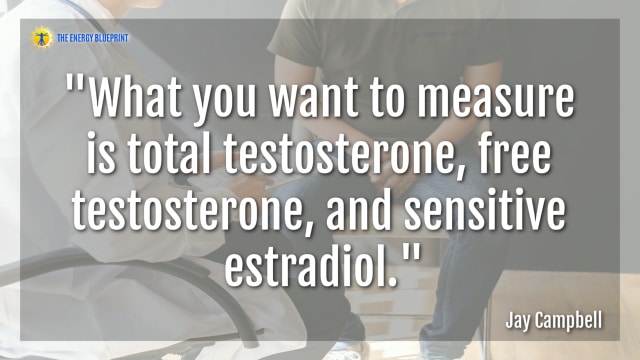 Jay Campbell is an international bestselling author, founder of the TOT (Testosterone Optimization Therapy) Revolution, and a global evangelist, teaching men, women, and their doctors how to optimize their hormones, their lives, and their happiness.
Jay Campbell is an international bestselling author, founder of the TOT (Testosterone Optimization Therapy) Revolution, and a global evangelist, teaching men, women, and their doctors how to optimize their hormones, their lives, and their happiness.
This article is derived from the Energy Blueprint Podcast episode with Jay on The Most Common Causes Of Low Testosterone (And How To Use Testosterone Replacement Therapy).
One of the Biggest Challenges of Conventional Treatment for Low Testosterone

Today more than ever before, men are going to their doctors because they are unable to get or maintain firm erections. They are typically offered one of two types of interventions:
- An SSRI inhibitor
- An erectile dysfunction medication
These two medications may help the man perform, but they won’t treat the underlying cause, which usually turns out to be a testosterone deficiency. Worse yet, SSRI inhibitors are mood-altering drugs that may lower testosterone levels even more.
Because many men who seek help for erectile dysfunction do not understand the connection between their symptoms and low testosterone levels, they rarely receive fair or accurate treatment. Besides, the average doctor doesn’t even consider looking at testosterone levels since prescribing drugs is so lucrative.
If you want to work on balancing your testosterone levels, you are better off finding a practitioner whose expertise is in endocrinology.
Testing for Testosterone Levels

The best way to examine your testosterone levels is to have them tested. Specifically, there are three hormones that you’ll want to pay special attention to:
- Total testosterone
- Free testosterone
- Sensitive estradiol
Oddly enough, sensitive estradiol measures estrogen levels. Men need a healthy level of estrogen for a variety of reasons, including to help regulate biological system health.
Due to modern lifestyle habits, most kids are predisposed to low testosterone levels. That is why Jay recommends that all men get their hormone levels tested before the age of 25.
So, how do you get your testosterone levels tested?
If you live inside the U.S., numerous labs offer testosterone tests for less than $100, and the process is relatively simple. You pay for the test online, print out the lab form, and go to your local LabCorp or Quest Diagnostics. They will perform the analysis and email you the result within a few days. If you live outside the U.S., you may want to talk to your doctor about how to best get these tests.
Key Point: The best way to verify your testosterone levels is by getting them tested. The three hormones that you want to focus on are total testosterone, free testosterone, and sensitive estradiol. The tests are relatively inexpensive, and you can order them online.
The Best Treatment Options for Testosterone
There are multiple delivery systems for testosterone, but there are only two which are reliable and with little to no long-term side effects:
- Injections
- A compounded cream
The best way to administer injectable testosterone is threefold: daily, twice daily, or twice a week. By applying the testosterone daily, you mimic the body’s testosterone production. However, daily injections seem to be too much for most, which is why the two latter options are often preferred.
According to Jay, the best frequency for injecting testosterone is daily or twice a week , mainly due to the half-life of testosterone. If you go with three or four days in between injections, you may experience a dip in mood.
If you think the compounded cream may be more suitable to you, applying it to the base of your scrotum in the morning is a good option. The skin around your scrotum is very thin and has a higher absorption rate than other parts of your body. Another potential bonus is that some men find they get slightly better erections as a result of applying the cream.
In any case, before you start using therapeutic testosterone, it is best if you dial in your lifestyle habits and talk to a professional about the best approach for you.
Key Points: The two best delivery systems for testosterone are injections and compounded cream. There are pros and cons for each system, and it ultimately comes down to your personal preference. Always talk to a health professional before starting any form of therapy.
The Best Approach for Someone Starting out with Testosterone Optimization Therapy

First, educate yourself. Starting testosterone therapy without educating yourself is likely a bad idea as your doctor probably lacks expertise in this field. The more you educate yourself, the easier it will be for you to get the help you need.
Secondly, seek out a physician who is highly specialized in managing the endocrine system in both men and women. You cannot rely on your family doctor. Most general practitioners have little to no knowledge about hormone optimization as it isn’t taught in medical school. So, unless the doctor has a personal interest in hormonal health, they are ill-equipped to assist you and answer your questions.
You must understand that there isn’t a one-size-fits-all approach to any type of biochemical treatment. We all have unique biochemistries, and what works for one person may not work for another. You may need to work with your practitioner for a while before the therapy is tailored to fit your needs.
Set yourself up for success by getting your labs done. Simply go online and purchase a lab test for total testosterone, free testosterone, and sensitive estradiol LC/MS.
Summary
Testosterone is an area of health most doctors know next to nothing about. They aren’t taught about it in medical school, so unless they have a personal interest in the topic, they are most likely ill-equipped to help you. In addition, the average doctor doesn’t even consider looking at testosterone levels since prescribing drugs is so lucrative. Unfortunately, some of these drugs have also been found to lower testosterone.
Before anything else, look into ways to support your natural testosterone production by optimizing your lifestyle habits. If you decide to proceed with testosterone therapy, you’ll need to put the time and effort into educating yourself. Getting your hormone levels tested and finding an endocrinologist who specializes in hormone therapy is a great starting point.
There are two types of testosterone therapy which seem to work best: injections and compounded cream. Speak with your practitioner about these options to find what works best for you.
There is no cure-all, one-size-fits-all approach to optimizing your testosterone levels. Finding what works the best for you will take patience and time spent working with an experienced practitioner.

Click here to listen to the full podcast with Jay Campbell on The Most Common Causes Of Low Testosterone (And How To Use Testosterone Replacement therapy)




